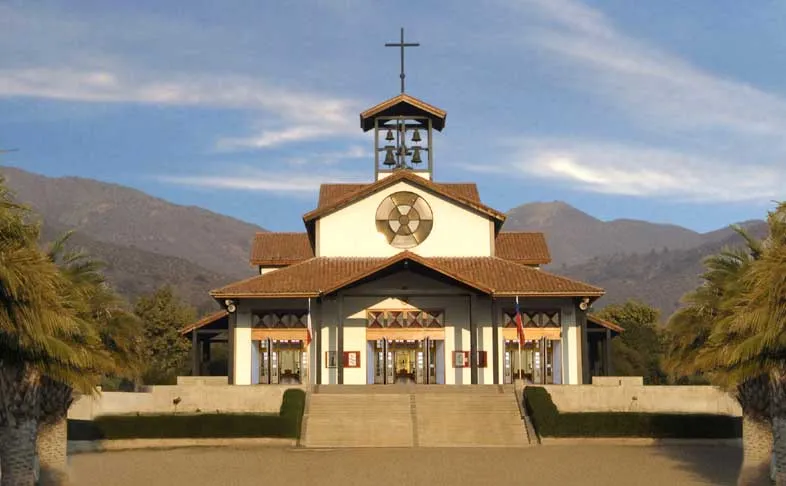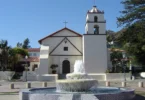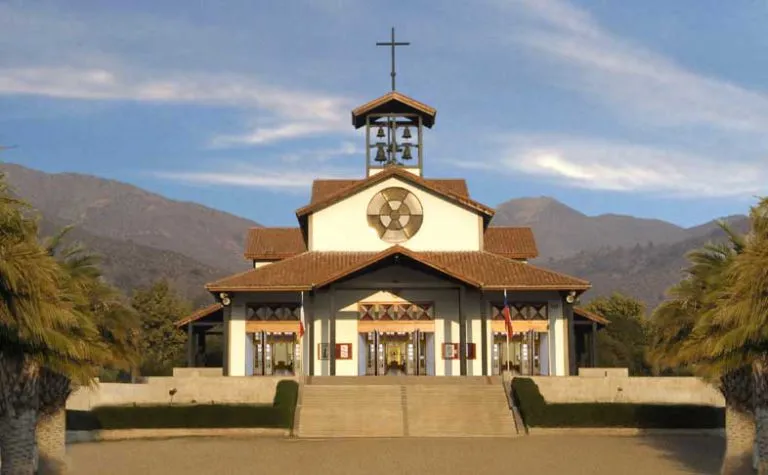
Introduction
The Sanctuary of Santa Teresa de Los Andes (El Santuario de Santa Teresa de Los Andes) is a religious site located in the commune of Rinconada, Los Andes Province, Chile. It was built to house the thousands of faithful who wish to venerate the relics of Santa Teresa de Los Andes, the first Saint of Chile.
In 1919, Teresa de Los Andes attended the Church of the Discalced Carmelites, passing away the following year. After her death, the buildings inside the enclosure became narrow for the nuns, which led to the place being expanded. Since the 1940s, there are records of parishioners who attribute miracles to the intervention of Santa Teresa, increasing in number over the years, forcing the transfer of the religious site to the town of Auco.
At the end of the 1980s, on the occasion of the visit of John Paul II to Chile, the beatification of Santa Teresa de Los Andes took place, on April 3, 1987, that same year, the religious site located in Los Andes, It is declared a National Monument of Chile, so that the following year, on January 16, 1988, the current sanctuary began its construction, being inaugurated in December of the same year.
History of Santuario de Santa Teresa de Los Andes
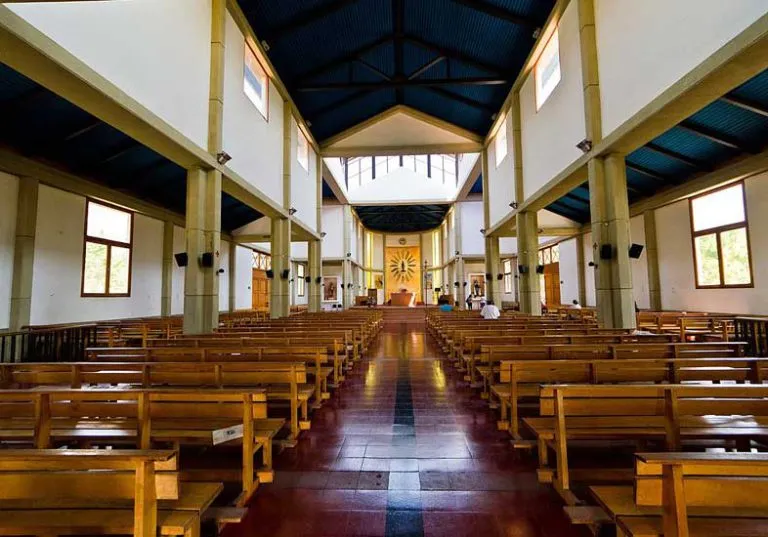
The Monastery of the Holy Spirit in the city of Los Andes, was the one that received the presence of Teresa de Los Andes then Juanita Fernández Solar, who entered as a postulant in 1919, spending only 11 months, while the convent was in charge of Mother Angelica Teresa of the Blessed Sacrament.
As the devotion to her person began immediately after her death (almost simultaneously with her death, one could say, because along with the news of her death in 1920 the phrase spread: “A Saint has died”), soon after they began Thanksgiving letters arrive at the monastery for favors granted, both spiritual and physical healing. Therese began to be seen as an intermediary between the Lord and men, for this reason, a few years after his death, the obituary circular had to be published again; people wanted to know more about his person, and that was how already in 1929 the public had the first biography of him.
In 1982, the Mothers decided that they would have to abandon the construction, due to the difficulty of closing it in the middle of the city and because Teresita summoned such a large number of faithful to the chapel that it was impossible to have them.
The “Holy War” – The resistance or rebellion of the Andeans against the idea that Teresa’s relics should leave their city, received the name of “holy war”, which was nothing more than the organized demonstration of what the inhabitants of Los Andes had expressed. before through various means: they did not want Teresa’s remains to leave their city.
Thousands of signatures were gathered opposing the transfer, but many of those who stamped did not even know that the monastery that was then located on Avenida Sarmiento, had been built 4 years after the death of Teresita (the original Monastery was located on the corner of Avda. Sarmiento with Calle Los Villares, currently a university headquarters), so it was not the historical place where the Saint had exercised her vocation.
Architecture
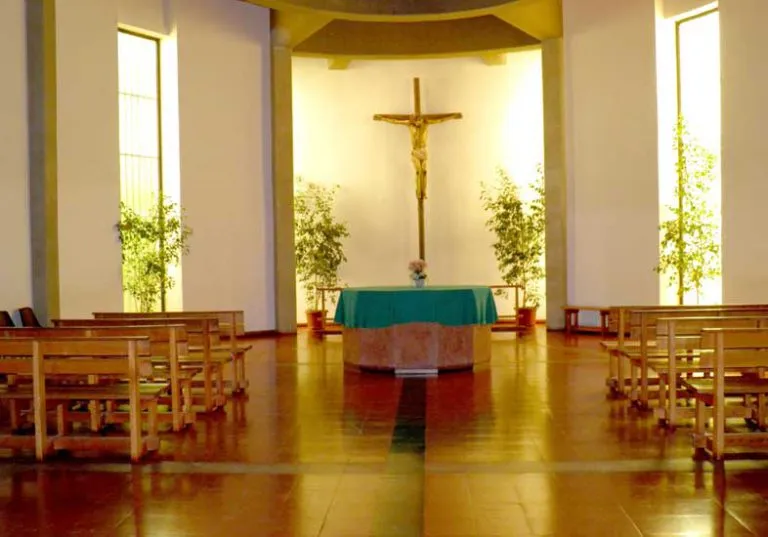
The place where the Sanctuary of Teresa de Los Andes is located, is located near the old Hacienda de Chacabuco, property of Santa Teresa’s grandfather. About 10 kilometers to the Southeast of Los Andes, in the commune of Rinconada de Los Andes, nestled at the foot of the mountain range that the ancients called the Serranías de Auco.
The name of the place comes from the indigenous voice AV and CO, which means “extreme waters” or also “scarce waters”. From the beatification in 1987, on the occasion of the visit to our homeland of HH Pope John Paul II, the construction of what is today the Sanctuary began.
The blessing of its fundamental stone was on January 16, 1988, in a ceremony that was attended by the Cardinal, Monsignor Juan Francisco Fresno and the Bishop of that time, Monsignor Manuel Camilo Vial, among other authorities and pilgrims. Teresita was transferred to the crypt on December 11, 1988, while the sanctuary was still not finished.
The style of the Sanctuary, like the Monastery, is colonial, with white walls, tiles and wooden eaves. Its construction is made of reinforced concrete, anti-seismic and both the temple and the crypt have 1000 m2 each. In addition to the austere and simple temple and crypt, where the relics of Santa Teresa are venerated, several buildings have arisen at the service of the thousands of pilgrims who come to it.
The arid and dry landscape of this Chilean corner has turned green and flourished with the thousands of trees planted in the surroundings and the gardens with which it is adorned. All of this makes the Shrine a place of spiritual experience, a place of true personal encounter and reconciliation with God.
Saint Teresa of Jesus of Los Andes

Teresa of Jesus of Los Andes (13 July 1900 – 12 April 1920), born as Juana Enriqueta Josephina de Los Sagrados Corazones Fernández Solar, (Spanish: Teresa de Jesús de Los Andes) was a Chilean professed religious from the Discalced Carmelites. Fernández Solar was a pious child but had an often unpredictable temperament for she could be prone to anger and being vain but could also demonstrate her charitable and loving nature; she seemed transformed when she decided to become a nun and her character seemed to change for her sole ambition was to dedicate herself to the service of God.
But her time in the convent was cut short due to her contracting an aggressive disease that killed her – she knew she would die but was consoled knowing she would be able to make her profession before she died.
Her canonization process opened on 23 April 1976 under Pope Paul VI and she became titled as a Servant of God. The confirmation of her life of heroic virtue on 22 March 1986 allowed for her to be titled as Venerable. Solar was beatified on 3 April 1987 in Chile after a miracle attributed to her from her native land cleared her for beatification while another miracle coming from Chile led Pope John Paul II to canonize her as a saint on 21 March 1993 in Saint Peter’s Square.
Life of Saint Teresa of Jesus of Los Andes
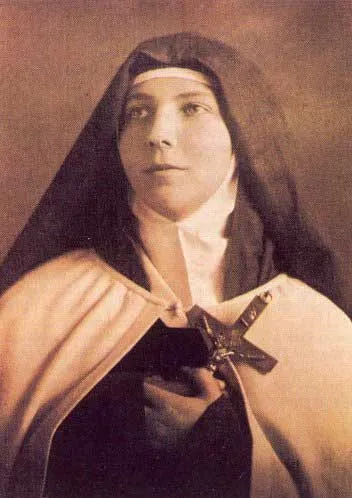
Juana Enriqueta Josefina de los Sagrados Corazones Fernández Solar was born in 1900 in Santiago in Chile to the upper class Miguel Fernández and Lucia Solar as the fourth of six children; three males and two females not including herself. Her brothers were Luis and Miguel and Ignacio and her sisters were Lucía and Rebeca.
On 31st December 1942 Rebeca became a Discalced Carmelite nun at the same convent as Juana as “Teresa of the Divine Heart”. Her mother was Lucía Solar de Fernández, her father was Miguel Fernández Jara and her maternal grandfather was Eulogio Solar. Her baptism was celebrated in the parish church of Santa Ana.
Fernández Solar received her education in a college managed by French nuns from the Sacred Heart order, and she remained there from 1907 until 1918. In 1914, she decided to consecrate herself to the Lord and become a Discalced Carmelite. On 8 December 1915, she made a vow to remain chaste and she renewed it on a regular basis. Fernández Solar was pious in character, but could also be stubborn and vain; she also lost her temper on some occasions. On one particular occasion, her sister Rebeca grew so fed up with Juana that she hit her while the red-faced Juana grabbed her with anger but stopped and kissed her cheek.
Rebeca was confused and unsure but chased her off and said: “Get out of here! You have given me the kiss of Judas!” Juana was hospitalized in 1913 for acute appendicitis. In her childhood, she also liked singing and dancing and played croquet and tennis. She was an able swimmer and could play the piano and harmonium. In 1916, she made a retreat for the Spiritual Exercises.
In her childhood, she read the autobiographical account that Thérèse of Lisieux had written and the experience had a profound effect on her pious and innocent character while also coming to the realization that she wanted to live for God alone. Fernández Solar had to work to overcome her initial self-centered character towards that of one directed to the caring of others above all. Her further inspiration for this self-transformation was her upcoming First Communion which led her to this commitment in an effort to achieve worthiness of what she was soon to receive.
Fernández Solar received her Confirmation on 22 October 1909 and made her First Communion later on 11 September 1910. In September 1917 she sent a letter to the prioress of the Discalced Carmelite convent close to her home expressing her desire to enter the order. On October 18, 1917 a nun distributed candies to the children but she grew frustrated when she was given a small piece so hurled it out of her hand and refused another piece that the nun offered her.
In late 1917 she and her mother left church and she turned to her mother in abruptness and asked whether she knew she would become a religious to which her mother told her that decision was for her father to make. Solar did not pursue it until from school she sent a letter to her father on 25 March 1919 that received no response; she returned home for a brief period but did not mention it and her father never alluded to it either but before she left for school again he consented when she asked him about it.
On 7 May 1919 she entered the novitiate of the Discalced Carmelites in Los Andes at which time she was given the new religious name of “Teresa of Jesus”; she later received the habit on the following 14 October. Toward the end of her short life the new nun began an apostolate of letter-writing in which she shared her thoughts on the spiritual life with others. But she soon contracted typhus that was diagnosed as fatal.
However, some historians have suggested that she might have contracted Spanish flu, which was devastating Chile at this time. In any case, her condition grew worse on 2 April 1920 – Good Friday. Sister Teresa was still three months short of turning 20 and had six months to complete her canonical novitiate so as to make her religious vows. But she nevertheless was allowed to profess her vows “in articulo mortis” (“facing death”) on 7 April 1920. Sister Teresa received the final sacraments on 5 April 1920 and later died at 7:15pm on 12 April 1920, one week after Easter. Her remains were later relocated in 1940 to a new chapel.
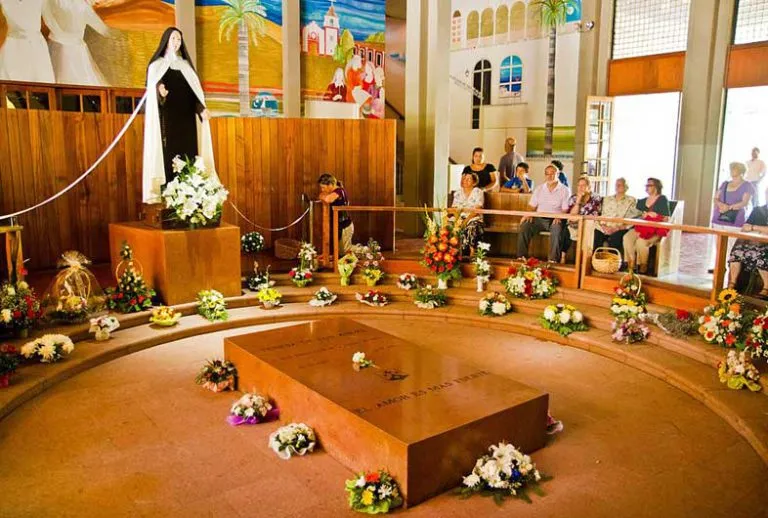
Sainthood
Teresa of Jesus remains popular with the estimated 100,000 pilgrims who visit on an annual basis the shrine where her remains are venerated in the Shrine of Saint Teresa of Los Andes in Los Andes. The nun is Chile’s first saint and is popular more so among women and adolescents. Teresa of Jesus was the first Discalced Carmelite outside of Europe to be proclaimed as a saint and is the fifth saint of the order with the name “Teresa”.
The beatification process began in an informative process in the Diocese of San Felipe from 20 March 1947 until its closure a few decades later on 14 January 1972; Bishop Roberto Bernardino Berríos Gaínza inaugurated this process while Enrique Alvear Urrutia oversaw its closure in a solemn Mass.
Theologians collected her writings for assessment and approved them as being in line with the faith on 7 March 1975. The formal introduction to the cause came on 23 April 1976 under Pope Paul VI and she henceforth became titled as a Servant of God. There was a cognitional process that was also opened in San Felipe and it spanned from 17 November 1976 until 18 March 1978 while the Congregation for the Causes of Saints validated the two previous processes in Rome on 20 March 1981.
The postulation later submitted the Positio to the C.C.S. in 1985 at which point theologians approved the cause on 3 December 1985 as did the cardinal and bishop members of the CCS on 18 March 1986. The confirmation of her model life of heroic virtue on 22 March 1986 allowed for Pope John Paul II to title her as Venerable after the C.C.S. Prefect Cardinal Pietro Palazzini bought the document to the pope for promulgation.
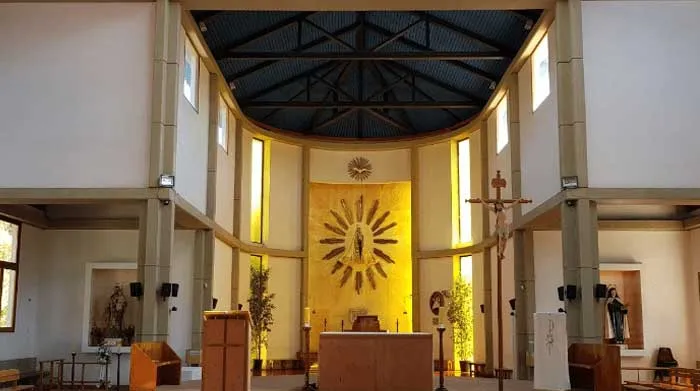
In Popular Media
Her life was used for the a Chilean television miniseries spanning from 6 August until 10 September 1989 starring Paulina Urrutia as Teresa of Jesus. Other films have been made about her life.
Facilities
In the crypt there are two murals that relate the life and message of Teresa de Los Andes, they are the work of the Benedictine nun Sr. Alejandra Izquierdo, helped by the then young muralist Gonzalo Correa. The latter also painted a beautiful allegory of light with geometric details, in the apse of the Temple (upper part of the Sanctuary), where the image of Our Lady of Mount Carmel is venerated and under which is the Tabernacle with the Blessed Sacrament.
Those in charge of the pastoral area are, since May 1988, the Discalced Carmelite Fathers and the Teresian Missionary Carmelite Sisters.
Pilgrimage
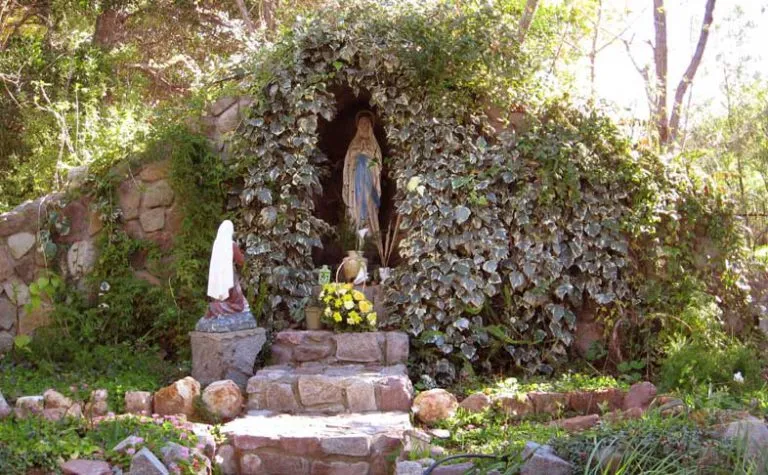
On the penultimate Saturday of October, the pilgrimage to the Sanctuary of Auco takes place, called ” Youth Pilgrimage: From Chacabuco to Carmelo, a path of Holiness”, which is also simplified as “Los Andes Walk”.
It has been organized since 1990 by the Vicaría de la Esperanza Joven of the Archbishopric of Santiago de Chile and consists of a walk, whose 27-kilometer route connects the town of Casas de Chacabuco, in the Colina commune, of the Metropolitan Region., with the sanctuary in the Valparaíso Region, through the Cuesta de Chacabuco. In the context of Social outbreak in Chile, the 2019 pilgrimage was suspended, while, during the COVID-19 Pandemic in Chile, the 2020 pilgrimage was animated virtually.
Feast Day – 12th April
Teresa of Jesus of the Andes was canonized by Pope St. John Paul II in 1993. She is the first Chilean saint and is the patron of young people and the sick. Her Feast Day celebrated on 12th April.
Mass Time
Weekdays
Saturdays & Sundays
Church Visiting Time
Contact Info
Carr. Gral. San Martín, Rinconada,
Provincia de Los Andes, Valparaíso, Chile.
Phone No.
Tel : +56 9 7488 7124
Accommodations
How to reach the Sanctuary
San Rafael Airport (Aeródromo de San Rafael de Los Andes) airport in Los Andes, Valparaíso Region, Chile is the nearby Airport to the Sanctuary.
Los Libertadores Subway Station in Quilicura, Santiago Metropolitan Region, Chile is the nearby Train Station to the Sanctuary.

